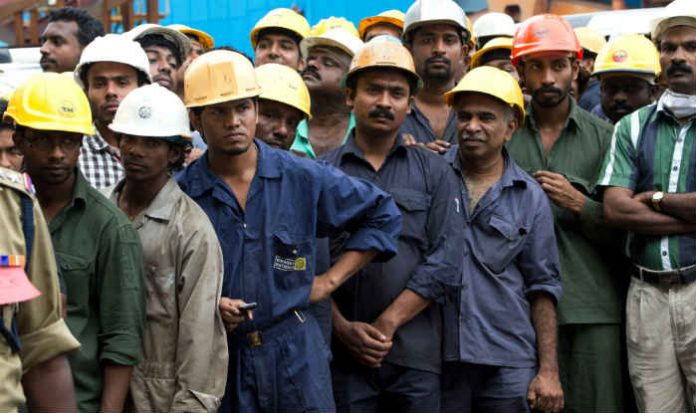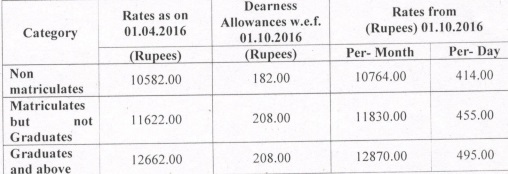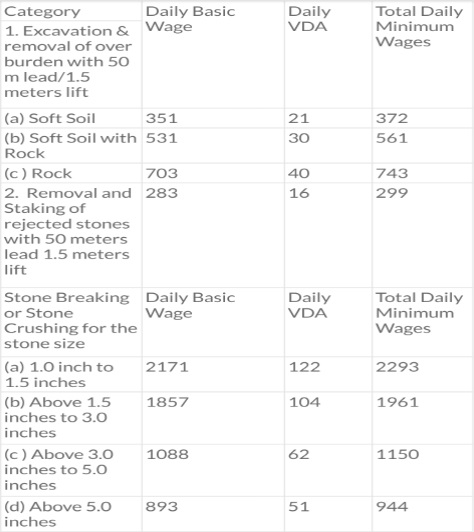In this article, Prashant Sharma of IIMT & School of Law, G.G.S.I.P.U discusses how minimum wages is determined under the Minimum Wages Act, 1948 in Delhi based establishments.
Introduction
The government stipulates the lowest wage to be paid to any employee keeping in mind the basic necessities, except for certain kinds of employment where less than a thousand people are employed in the entire state. Depending on the nature of the occupation, minimum wages may be determined by the State Government, in which case it will vary from state to state or by the Central Government. This is specified under the Minimum Wages Act.
The Minimum Wage Act, 1948 was passed with an objective to secure the welfare and the interest of the workers who are employed in certain establishments in order to be protected in the today’s competitive market. This Act helps the workers to prevent them from getting exploited by the employers or the management.
To put it into the legal perspective, minimum wages includes:
- A basic rate of wages + a special allowance; or
- A basic rate of wages with or without the cost of living allowance and the cash value of the concessions; or
- An all-inclusive rate allowing for the basic rate, the cost of living allowance and the cash value of the concessions, if any.
As per Article 43 the Directive Principles of State Policy, the State shall endeavor to secure, by suitable legislation or economic organisation or in any other way, to all workers agricultural, industrial or otherwise, work, a living wage, conditions of work ensuring a decent standard of life and full enjoyment of leisure and social and cultural opportunities and, in particular, the State shall endeavour to promote cottage industries on an individual or co-operative basis in rural areas.
Criteria to fix Minimum Wages
In the year 1948, the Tripartite Committee on Fair Wages was appointed by the Central Advisory Council. The said committee had laid down a certain criterion for minimum wages. Such criterion provides 5 elements which have to be considered while fixing the minimum wages. These are as follows:
- 3 consumption units per earner;
- Minimum food requirement of 2700 calories per average adult;
- Cloth requirement of 72 yards per annum per family;
- House rent corresponding to the minimum area provided under the Government’s Industrial Housing Scheme;
- Fuel, lighting and other miscellaneous items of expenditure to constitute 20% of the total minimum wage.
Adding to it, the Appropriate Government have the power to fix the minimum rates of wages. It can fix the minimum rates of wages either: (see here)
- by the hour; or
- by the day; or
- by the month or
- by such large wage period as may be prescribed.
Section 3 and Section 5 of the Act talks about fixation of minimum wages and procedure of fixing the minimum wages respectively. As minimum wages includes many elements as mentioned above, it also includes industrial dearness allowances, for all the industrial employees which were covered under the Act.
How to find Minimum Wages
To know about the minimum wage of any worker in an establishment of a concerned State, kindly go to the official website of Labour Government. For instance the current minimum wage rate for the Union Territory of Delhi can be reached here.
Delhi Labour Department Notification
The Labour Department in 2016, have issued the revised minimum rate of wages for Delhi for the class of workmen/employees. To know about the minimum wage of any worker in an establishment of a concerned State, kindly go to the official website of Labour Government. For instance the current minimum wage rate for the Union Territory of Delhi can be reached here.
- In order to calculate the daily wage, monthly gross salary is divided by 30, as the weekly offs are taken as the pay leaves. (The salary is to be divided by 30, irrespective of the actual number of days in a month).
- However, in case of daily wages, the weekly offs are not counted as paid leaves and therefore, are paid only for 26 days.
Therefore, we can calculate it as follows:
Salary per month (Gross)/ 30 days in a month x No. of days present
Example: Rs.11,830/26 = Rs.455/- are the daily wages which can be multiplied by number of days he was working to find out his/her actual minimum wage he will get in hand.
Dearness Allowances
The Dearness Allowance (DA) is a cost of living adjustment allowance paid to Government employees, Public sector employees (PSE) and pensioners. It is payable to monthly, daily and piece rate earners. The respective State Governments issue the Cost Of Living Index number every six months for each and every scheduled employment.
The following formula is being used by the Central Government to calculate the dearness allowance for the Central Government Employees, after implementing the recommendations of the 7th Pay Commission, from July 1st 2016 onwards.
The formula is:
Dearness Allowance% = (Average of AICPIN for the past 12 months – 261.4) * 100 / 261.4
(see here)
AICPIN stands for the All India Consumer Price Index. Dearness allowance is calculated from the AICPIN value, once the AICPI(IW) for a particular month is published by the Government. AICPIN are issued by the Ministry of Labour and Employment, which are revised periodically. The site can be accessed here.
The dearness allowances are revised by the government twice a year. It was increased by the Central Government from 5% to 7% when was revised in January 2018 (see notification here).
Revised Rates of Variable Dearness Allowance by The Central Government
The minimum rates of wages include the basic rates and Variable Dearness Allowance. The revised rates of Variable Dearness Allowance on the basis of the average Consumer Price Index for Industrial Workers, for the workers employed in various jobs w.e.f. 01.04.2018 were specified in a notification by the Chief Labour Commission dated 4th April 2018 can be accessed as follows:
- Industrial workers in agriculture (see here, page 1)
- Industrial workers in mines (see here, page 2)
- Industrial workers of construction and maintenance of roads or building operations (see here, page 3)
- Industrial workers of stone mines (see here, page 4)
- Industrial workers who are employed for Sweeping and Cleaning excluding the activities prohibited under the Employment of Manual Scavengers and Construction of Dry Latrines Prohibition Act 1993 (see here, page 6)
- Industrial workers for watchman and ward (with or without arms) (see here, page 7)
Revised Minimum Wage in Delhi, Gujarat, Chattisgarh, Tripura, West Bengal
The image shows a part of the table.
Image Source: https://clc.gov.in/clc/node/572.
The daily Basic Wage + Daily VDA = Total Minimum Wages
Maintenance of Register and Records
Every employer in an establishment shall maintain such registers and records giving such particulars of the wages paid to employees employed by him, the receipts given by them. (see here)
In cases of maternity relief
The maternity leave is awarded full pay on completion of at least 80 days in an establishment in the 12 months prior to her expected date of delivery. The maternity benefit is awarded at the rate of the average daily wage for the period of a worker’s actual absence from work. Apart from 12 weeks of salary, a female worker is entitled to a medical bonus of 3,500 Indian rupees.
However, the government has amended the Act in 2017, after which the duration of maternity leave has been increased from 12 to 26 weeks which can be availed prior to 8 weeks from the date of expected delivery (earlier it was 6 weeks prior). From third child onwards, maternity leave of 12 weeks will be available instead of 26 weeks, that could be availed 6 weeks prior.
In cases of worker who took leaves
Suppose, A is a person who is a semi-skilled worker in an XYZ Industry. He had worked for 20 days in a month and had taken 6 days leave. So, his minimum wages for a month should be:
Total Minimum Wage for one month – Minimum Wage for 6 days i.e.,
Rs. 10,764 – (Rs. 414 x 6)= Rs.8,280/-
(as per the 2016 Delhi Government notification)
Amendments in Delhi
The recent amendments in the Minimum Wage Act, 1948 were been made by the Delhi Assembly. The Minimum Wages (Delhi) Amendment Act, 2017,which is officially notified on May 4, 2018, has certainly proved to be beneficial for the employees (as under Section 2(i) of the Minimum Wage Act, 1948) against the acts of the employers when he provides wages less than minimum wages.
According to Section 22 of the amended Act, the punishment for an employer providing wages less than minimum wages is increased from 6 months to three years and/or the fine is increased from Rs. 500/- to up to 50,000/-.
Further, in the case of other States, an employer can be liable under Section 22 of the Minimum Wages Act, 1948. To know about the minimum wages for the other States, kindly refer to the recent amendments that have been made for the respective States.
Conclusion
Recently, the High Court of Delhi had quashed the Delhi Labour Department Notification of 2017 for revised minimum wage for all the industrial establishments situated at Delhi. One of the Judge. The High Court observed that the formation of the Minimum wage advisory committee under Section 5 and 9 of the Minimum Wage Act, 1948 is ultra virus. Further, the Court declared the act of revising the minimum wage was a “hurried action” taken by the Government of Delhi and the committee was not constituted a per the Act which is violative of Article 14 of the Constitution of India.
The consequence of this action was that from now on, the wages of the workers from unskilled to skilled ones shall be given as per the 2016 Labour Department notification which is quite low in comparison. Once again, the poor have to face the dramatic and drastic effect.















